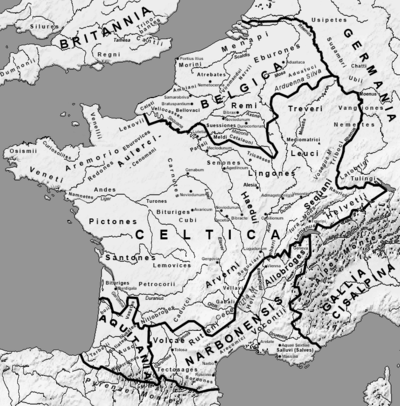Lingones
The Lingones (Gaulish: "the jumpers") were a Gallic tribe of the La Tène and Roman periods. They dwelled in the region surrounding the present-day city of Langres, between the provinces of Gallia Lugdunensis and Gallia Belgica.[1]

Name
Attestations
They are mentioned as Língōnes (Λίγγωνες) by Polybius (2nd c. BC),[2] as Lingones by Caesar (mid-1st c. BC), Pliny (1st c. AD) and Tacitus (early 2nd c. AD),[3][4][5] as Díngones (Δίγγονες) by Strabo (early 1st c. AD),[6] and as Lóngōnes (Λόγγωνες) by Ptolemy (2nd c. AD).[7][8]
Etymology
The name Lingones stems from the Gaulish ling- ("to jump"), ultimately from the Proto-Celtic verbal base *leng- ('to jump'; compare with Old Irish lingid "he jumps").[9][10][11] Lingones thus probably meant "the jumpers",[12][10] perhaps "good at jumping (on horseback)",[12] or "the dancers".[10]
The city of Langres, attested as civitas Lingonum ca. 400 AD, is named after the Gallic tribe.[12]
Geography
The territory of the Lingones was situated on the border separating Gallia Lugdunensis from Gallia Belgica, between the Senones and the Sequani.[1]
Settlement
Their capital Andematunnum (present-day Langres, Haute-Marne) is attested from 43 AD on boundary markers (abbreviated as AND).[12][13] It was built on a Bajocian limestone promontory, overlooking the Marne valley to the east and north, and the Bonnelle valley to the west. Only the southern part, open to the Langres plateau, did not possess natural defences.[13] Archeological evidence have demonstrated a continuity between the La Tène and Roman periods on the site of Langres, and the city of Andematunnum appears to have been built at the turn of the 1st century BC on a previous Gallic settlement.[14] The Roman-era civitas of the Lingones was located at the crossroad of the modern départments of Aube, Haute-Marne, Côte d’Or and Yonne.[15]
The Cathedral St-Mammes, built in the Burgundian Romanesque style for the ancient diocese that was referred to as Lingonae ("of the Lingones") and rivalled Dijon. Three of its early bishops were martyred by the invasion of the Vandals, about 407.
History
Some of the Lingones migrated across the Alps and settled near the mouth of the Po River in Cisalpine Gaul of northern Italy around 400 BC. These Lingones were part of a wave of Celtic tribes that included the Boii and Senones (Polybius, Histories ii.17). The Lingones may have helped sack Rome in 390 BC.
The Gaulish Lingones did not participate in the battles of the Gauls against Caesar. They gained Roman citizenship at the end of the first century CE,[1] living in a rich and urbanized society in the region of Langres and Dijon and minting coins. They were caught up in the Batavian rebellion (69 AD) described by Tacitus.
The strategist Sextus Julius Frontinus, author of the Strategemata, the earliest surviving Roman military textbook, mentions the Lingones among his examples of successful military tactics:
In the war waged under the auspices of the Emperor Caesar Domitianus Augustus Germanicus and begun by Julius Civilis in Gaul, the very wealthy city of the Lingones, which had revolted to Civilis, feared that it would be plundered by the approaching army of Caesar. But when, contrary to expectation, the inhabitants remained unharmed and lost none of their property, they returned to their loyalty, and handed over to me seventy thousand armed men.
In Roman Britain, at least three named cohorts of Lingones, probably subscripted from among the Lingones who had remained in the area of Langres and Dijon are attested in the 2nd and 3rd centuries, from dedicatory inscriptions and stamped tiles. The 1st cohort of Lingones (part-mounted ) is attested at Bremenium,[16] the 2nd cohort of Lingones is attested at Ilkley Roman Fort by their Prefect,[17] and the fourth cohort built part of Hadrian's Wall near Carlisle.[18]
Religion
During the Roman period, Mars Cicolluis was the main god of the Lingones.[19]
See also
- Ancient peoples of Italy
- Celts in the Alps and Po Valley
- Lepontii
- Prehistoric Italy
References
- Lafond 2006.
- Polybius. Historíai, 2:17:7
- Caesar. Commentarii de Bello Gallico, 1:25:6; 1:40:11
- Pliny. Naturalis Historia, 4:106
- Tacitus. Historiae, 1:53
- Strabo. Geōgraphiká, 4:3:4
- Ptolemy. Geōgraphikḕ Hyphḗgēsis, 2:9:9
- Falileyev 2010, p. entry 4136.
- Lambert 1994, p. 34.
- Delamarre 2003, p. 203.
- Matasović 2009, p. 237–238.
- Nègre 1990, p. 155.
- Joly 2003, p. 211.
- Joly 2003, pp. 213–214.
- Joly et al. 2015, p. 217.
- "RIB 1276. Dedication-slab". Roman Inscriptions of Britain online. Retrieved 2 June 2020.
- "RIB 635. Altar dedicated to Verbeia". Roman Inscriptions of Britain online. Retrieved 2 June 2020.
- "RIB 2014. Building inscription of the Fourth Cohort of Lingonians". Roman Inscriptions of Britain online. Retrieved 2 June 2020.
- Derks 1998, p. 97.
Bibliography
- Delamarre, Xavier (2003). Dictionnaire de la langue gauloise: Une approche linguistique du vieux-celtique continental (in French). Errance. ISBN 9782877723695.CS1 maint: ref=harv (link)
- Derks, Ton (1998). Gods, Temples, and Ritual Practices: The Transformation of Religious Ideas and Values in Roman Gaul. Amsterdam University Press. ISBN 978-90-5356-254-3.CS1 maint: ref=harv (link)
- Falileyev, Alexander (2010). Dictionary of Continental Celtic Place-names: A Celtic Companion to the Barrington Atlas of the Greek and Roman World. CMCS. ISBN 978-0955718236.
- Joly, Martine (2003). "Les Origines de l'Antique Capitale des Lingons". Revue Archéologique (1): 211–214. ISSN 0035-0737. JSTOR 41017496.
- Joly, Martine; Izri, Stéphane; Maligorne, Yvan; Barral, Philippe; Coquet, Nicolas; Nouvel, Pierre (2015). "Langres/Andemantunum, capitale des Lingons". Gallia. 72 (1): 217–230. doi:10.4000/gallia.1534. ISSN 0016-4119. JSTOR 44744316.
- Lafond, Yves (2006). "Lingones". Brill's New Pauly.CS1 maint: ref=harv (link)
- Lambert, Pierre-Yves (1994). La langue gauloise: description linguistique, commentaire d'inscriptions choisies (in French). Errance. ISBN 978-2-87772-089-2.CS1 maint: ref=harv (link)
- Matasović, Ranko (2009). Etymological Dictionary of Proto-Celtic. Brill. ISBN 9789004173361.CS1 maint: ref=harv (link)
- Nègre, Ernest (1990). Toponymie générale de la France (in French). Librairie Droz. ISBN 978-2-600-02883-7.CS1 maint: ref=harv (link)
